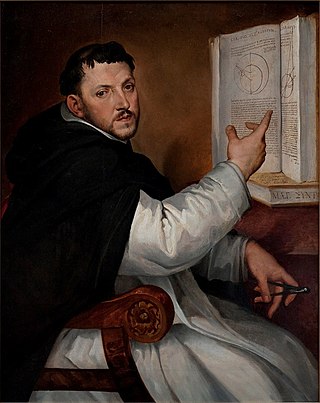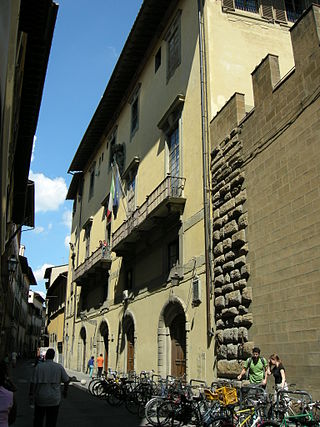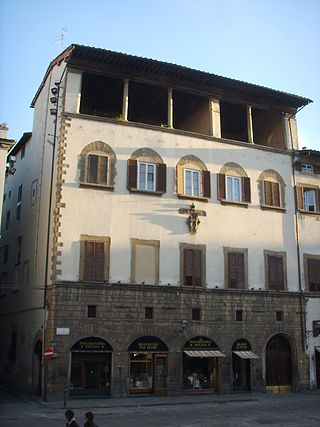
The Pazzi conspiracy was a failed plot by members of the Pazzi family and others to displace the Medici family as rulers of Renaissance Florence.
Dell'Arcano del Mare by Sir Robert Dudley is a 17th-century maritime encyclopaedia, the sixth part of which comprises a maritime atlas of the entire world, which is the first such in print, the first made by an Englishman, and the first to use the Mercator projection. The work was first published in Italian at Florence in 1645 and 1646 in three folio volumes.

The Palazzo Vecchio is the town hall of Florence, Italy. It overlooks the Piazza della Signoria, which holds a copy of Michelangelo's David statue, and the gallery of statues in the adjacent Loggia dei Lanzi.

Ferdinando I de' Medici, Grand Duke of Tuscany was Grand Duke of Tuscany from 1587 to 1609, having succeeded his older brother Francesco I.

Vincenzo Ι Gonzaga was the ruler of the Duchy of Mantua and the Duchy of Montferrat from 1587 to 1612.

There are more than 900 churches in Rome, which makes it the city with the largest number of churches in the world. Almost all of these are Catholic.

IgnazioDanti, O.P., born Pellegrino Rainaldi Danti, was an Italian Roman Catholic prelate, mathematician, astronomer, and cosmographer, who served as Bishop of Alatri (1583–1586).

Santa Trinita is a Roman Catholic church located in front of the piazza of the same name, traversed by Via de' Tornabuoni, in central Florence, Tuscany, Italy. It is the mother church of the Vallumbrosan Order of Monks, founded in 1092 by a Florentine nobleman. South on Via de' Tornabuoni is the Ponte Santa Trinita over the river Arno; across the street is the Palazzo Spini Feroni.

Giambattista Nolli, was an Italian architect and surveyor. He is best known for his ichnographic plan of Rome, the Pianta Grande di Roma which he began surveying in 1736 and engraved in 1748, and now universally known as the Nolli Map. The map is composed of 12 copper plate engravings that together measure 176 centimetres (69 in) by 208 centimetres (82 in). It was produced and published in response to the commission of Pope Benedict XIV to survey Rome in order to help create demarcations for the 14 traditional rioni or districts. It was by far the most accurate description of Rome produced to date at a time when the architectural achievement of the Papacy was in full flower.

Francesco Panigarola was an Italian Franciscan preacher and controversialist, and Bishop of Asti.

The Biblioteca Riccardiana is an Italian public library under the aegis of the Ministry of Culture, located inside the Palazzo Medici Riccardi at 10 Via de’ Ginori in Florence, in the neighborhood comprising the Mercato Centrale and the Basilica di San Lorenzo. Its main feature is preserving books collected by members of the Riccardi family and making them available in the very same rooms that were originally dedicated to that purpose. So, still today the library boasts the magnificent bookshelves, neatly carved and gilded, that create the atmosphere of a late-seventeenth-century patrician library, whose main features have all been kept intact.

Vincenzo Borghini was an Italian monk, artist, philologist, and art collector of Florence, Italy.

The Teatro Goldoni of Florence was first opened in 1817 at the site of the former Annalena monastery in Oltrarno, region of Tuscany, Italy. The theater, dedicated to the playwright Carlo Goldoni, has a main facade on the narrow Via Santa Maria #15, it is near the corner with Via de Caldaie.

The Porta Romana, once known as the Porta San Pier Gattolino was the southernmost gate in the 13th-century walls of the Oltrarno section of Florence, region of Tuscany, Italy. It stands at the confluence of a number of roads: accessed from north by Via Romana, Via de' Serragli, and Viale Francesco Petrarca. In addition, a central road along the Boboli Gardens begins near the gate, and allowed the inhabitants of the Pitti Palace to exit and enter Florence with minimal travel on city streets. Beyond the gates are the Via del Poggio Imperiale and Via Senese. The latter led to Siena and points south such as Rome, hence the name. When the majority of the defensive walls of Florence were razed in the 19th century, only a few, and sometimes partial gate structures were left standing including San Gallo Gate, Tower of San Niccolò, and this gate with a snippet of merlonated wall.
Alderano Cybo-Malaspina was an Italian nobleman. He was marquess of Carrara, count of Ferentillo, first Duke of Ferentillo from 1603, Roman Patrician and Genoese Patrician, Patrician of Pisa and Florence, Patrician of Naples and Noble of Viterbo. He was the only son of Alberico I, sovereign prince of Massa and Carrara, by his first wife Elisabetta della Rovere, but, despite being Alberico's heir, he never ascended the throne, having predeceased his father.

The two fontane dei mostri marini are located in the Piazza della Santissima Annunziata in Florence, Italy.

Stefano Bonsignori or Buonsignori was an Italian Olivetan monk and cartographer to Francesco I, Grand Duke of Tuscany. He was born in Florence and is most notable for his eponymous Bonsignori Map of Florence.

Lionardo Salviati (1539–1589) was a leading Italian philologist of the sixteenth century. He came from an illustrious Florentine family closely linked with the Medici. Salviati became consul of the Florentine Academy in 1566, and played a key role in the founding of the Accademia della Crusca, with its project of creating a dictionary, which was completed after his death.

Palazzo Della Stufa or Lotteringhi Della Stufa, is in the Piazza San Lorenzo, at the corner of Via della Stufa, in Florence, Italy, in front of the Basilica di San Lorenzo.

Giovanni Battista Lorenzi, known as Battista Lorenzi or Battista del Cavaliere, was an Italian sculptor.


















